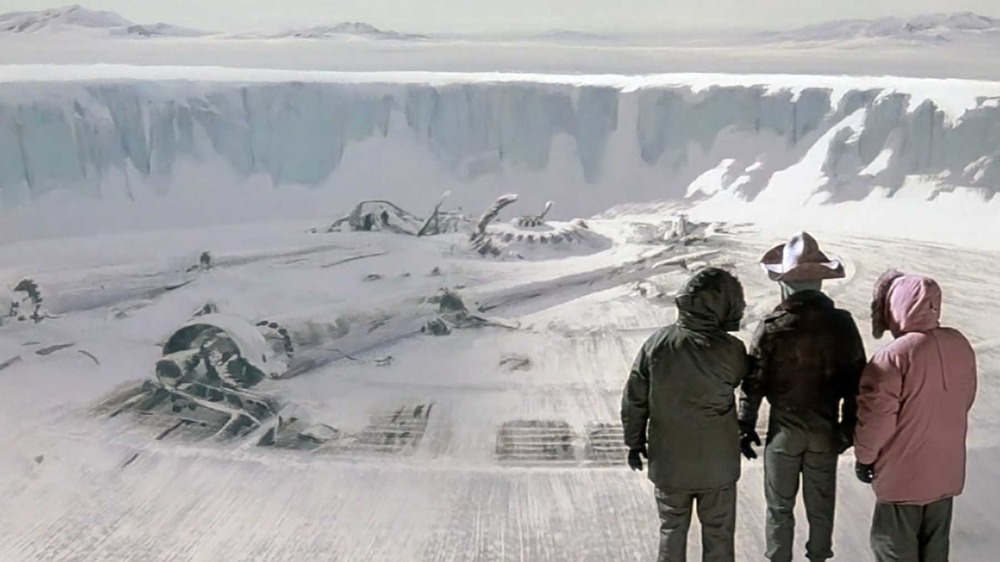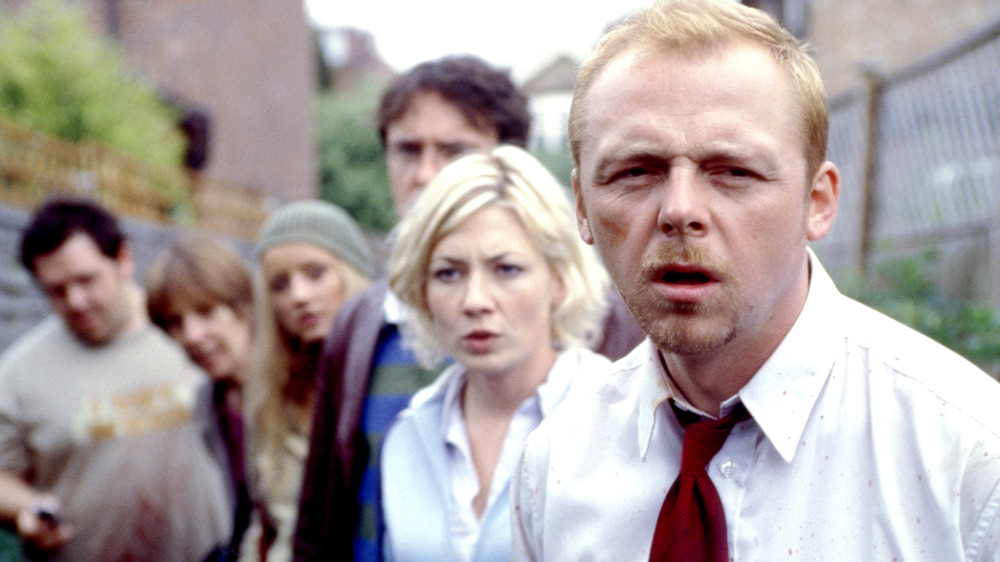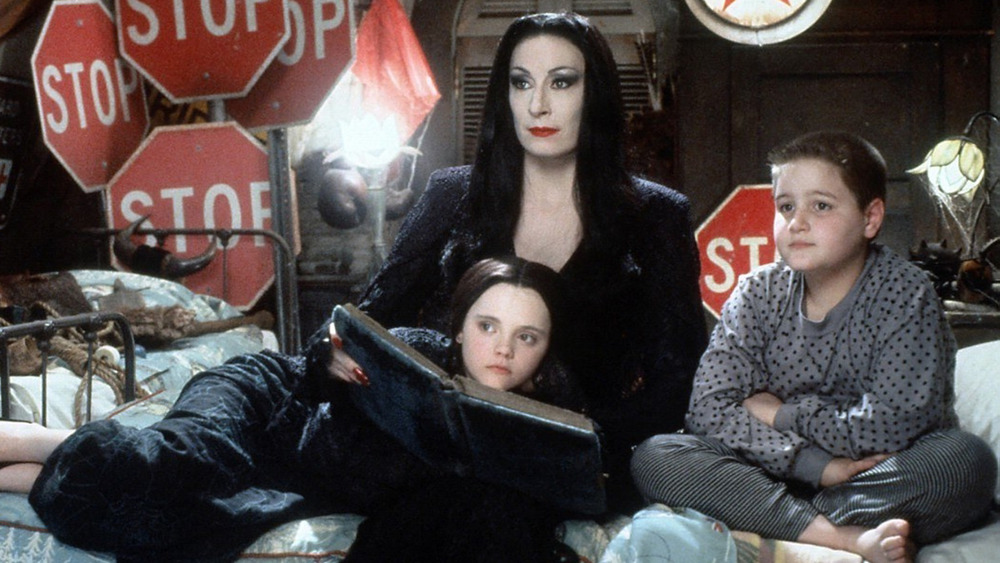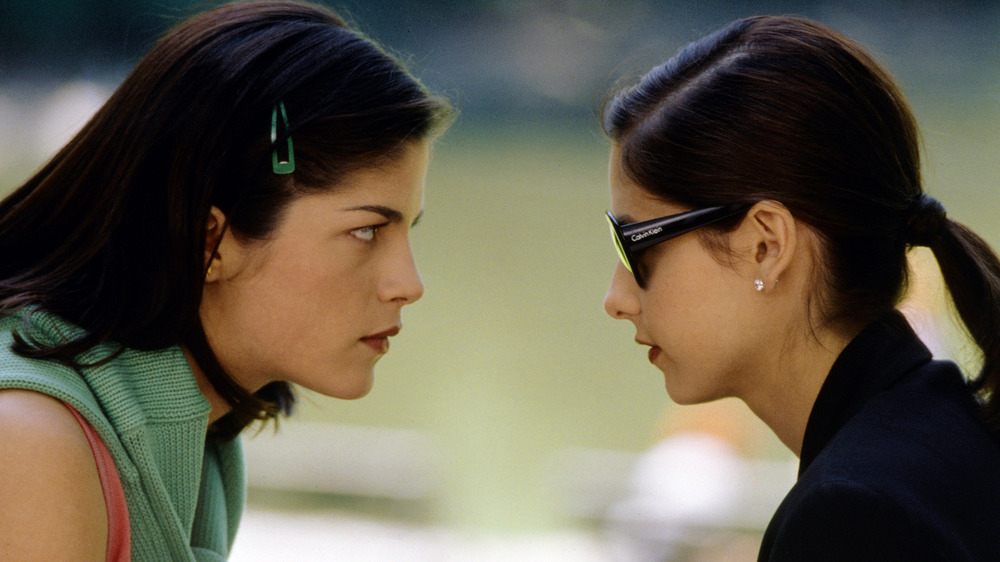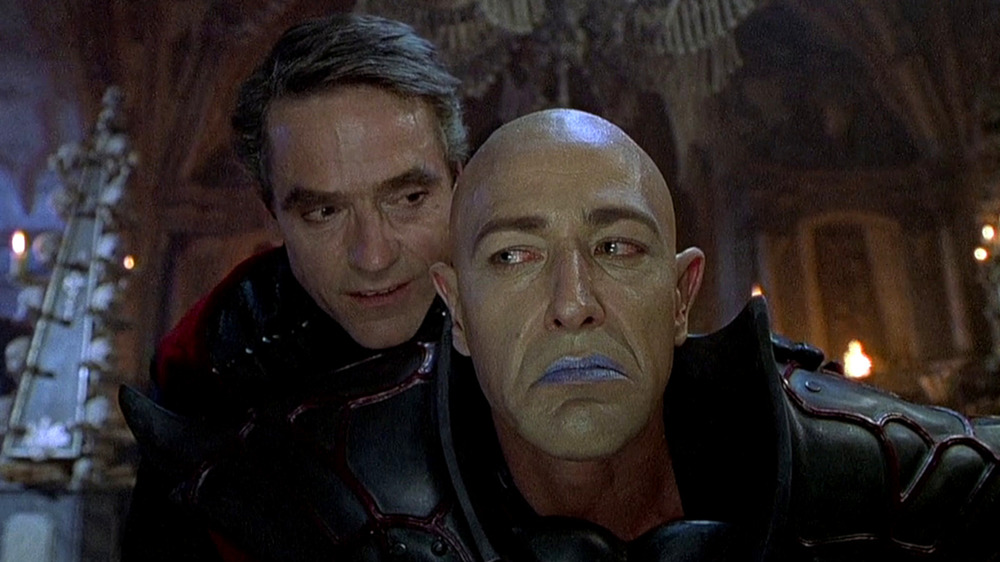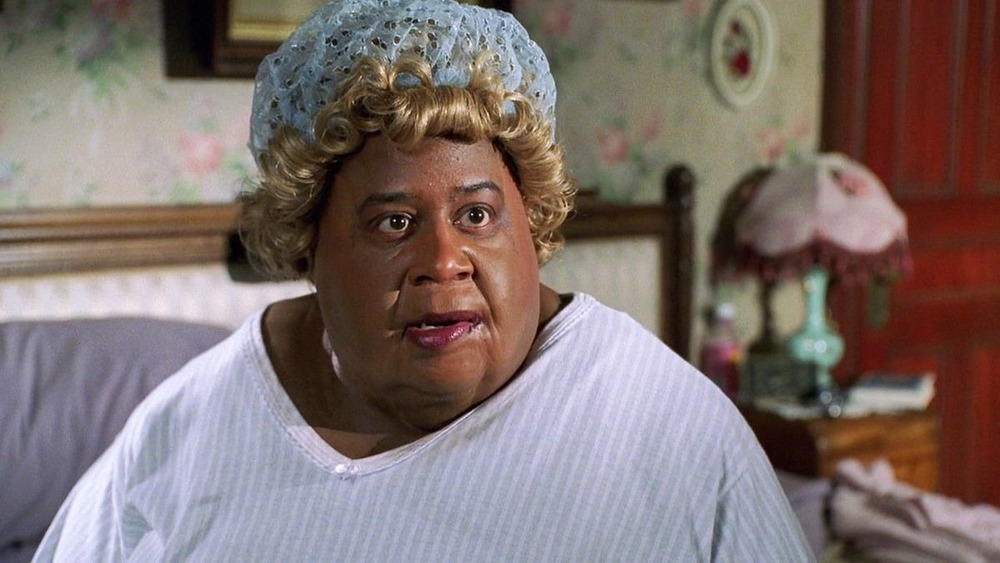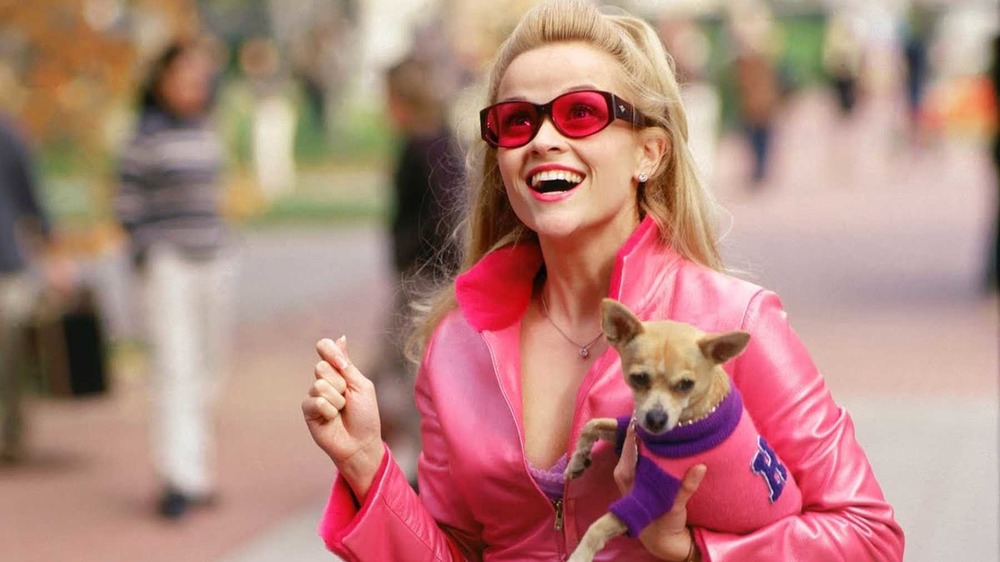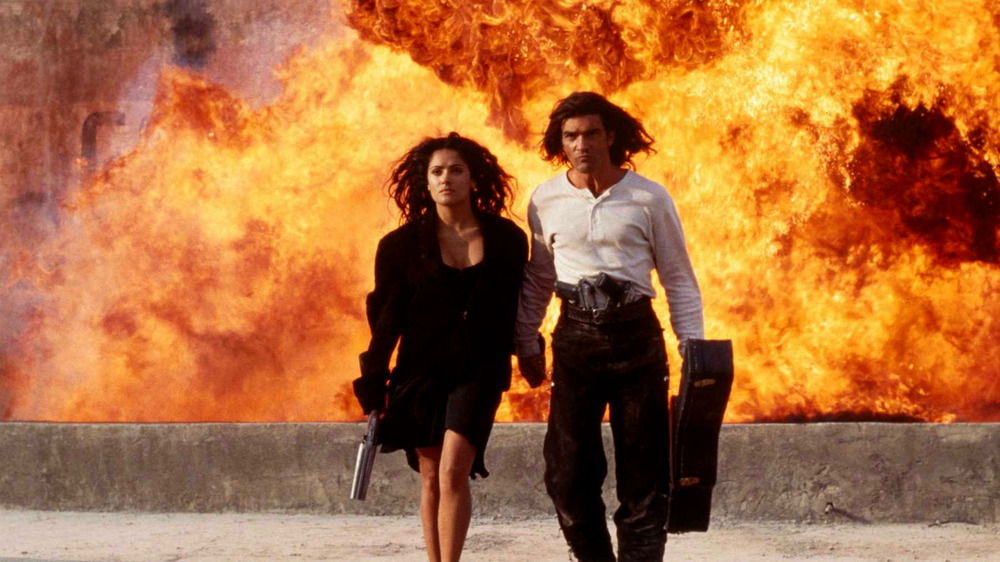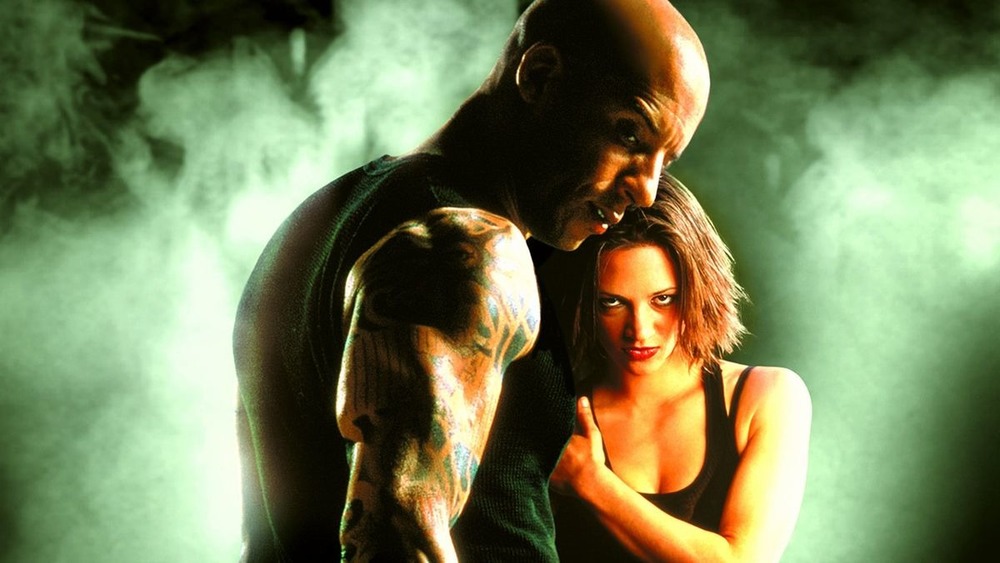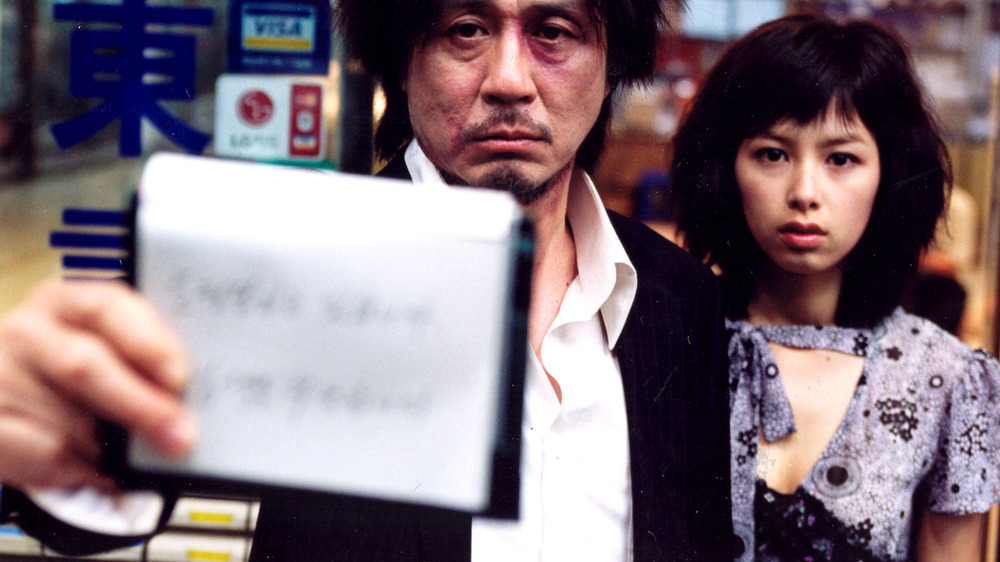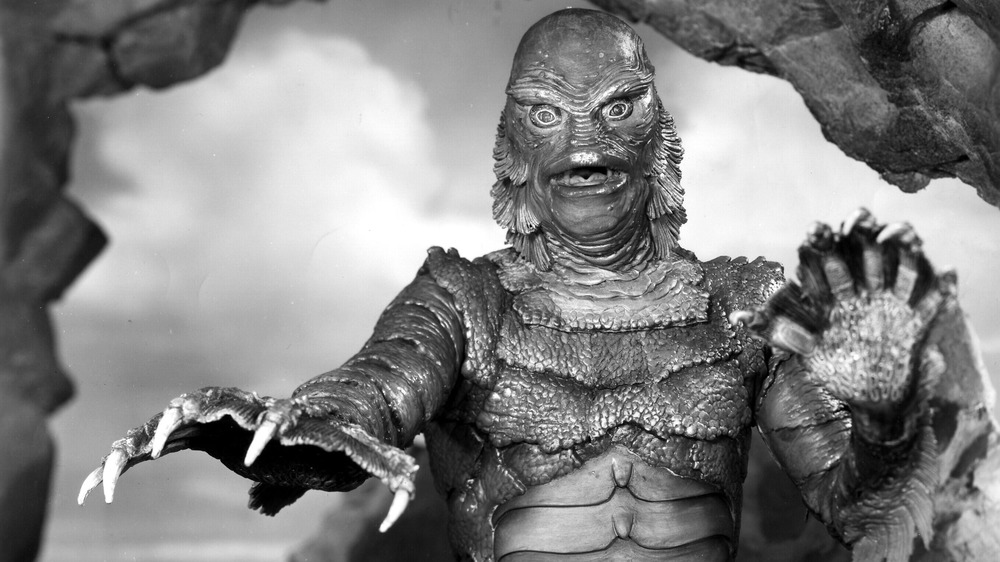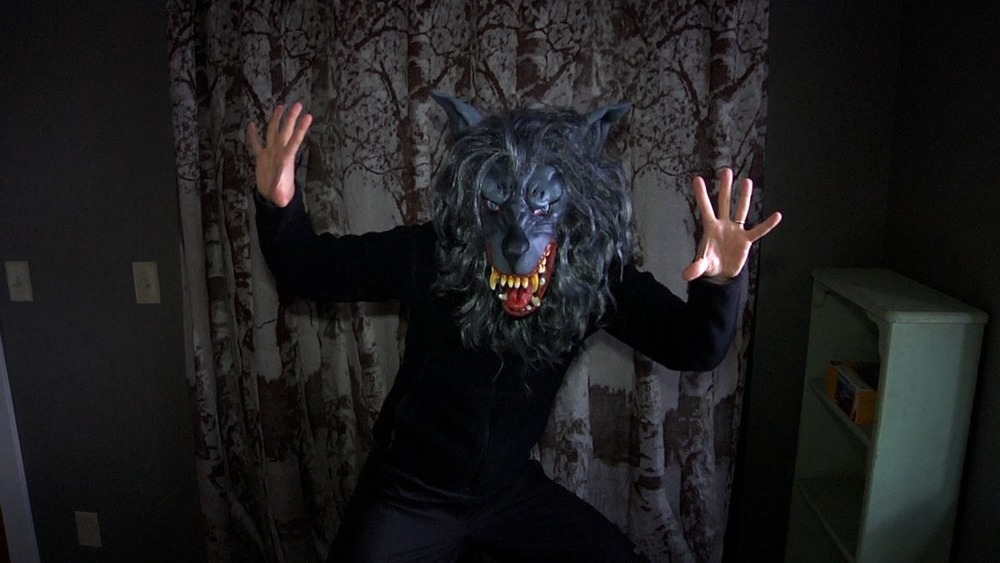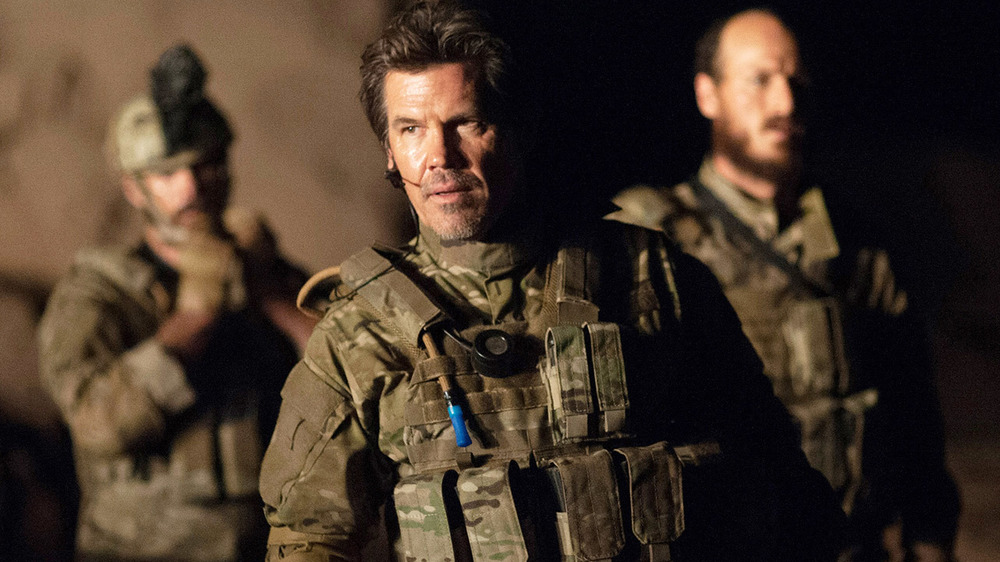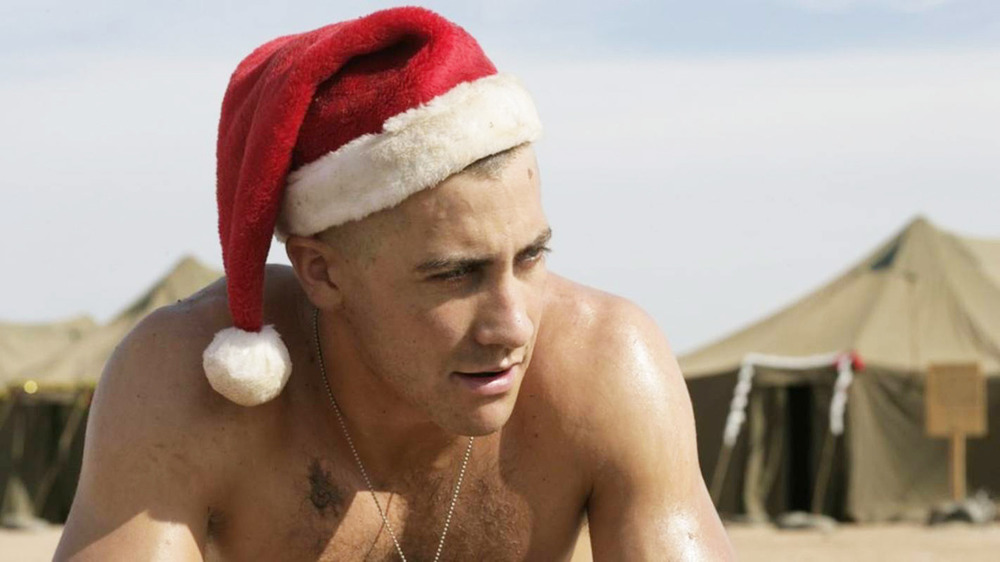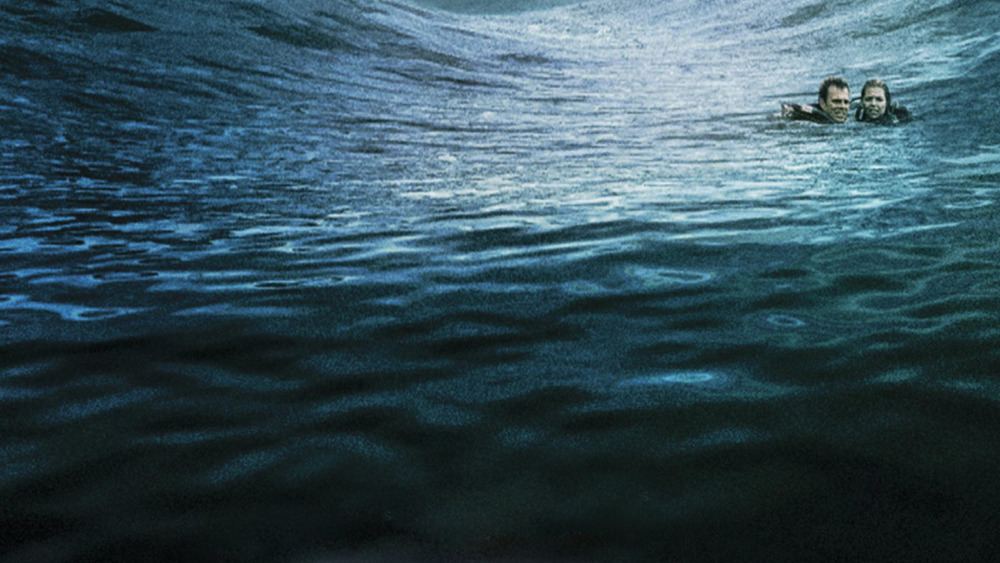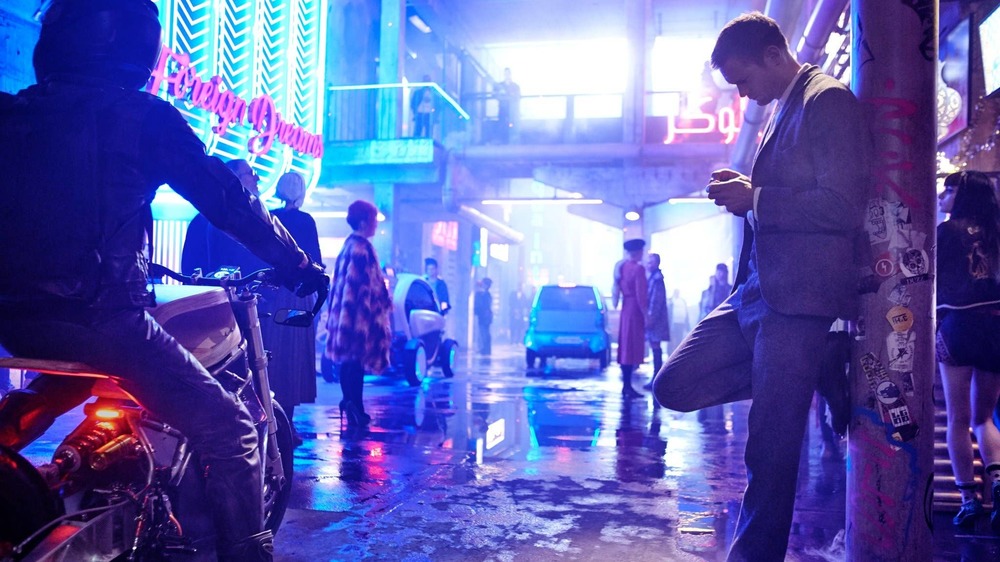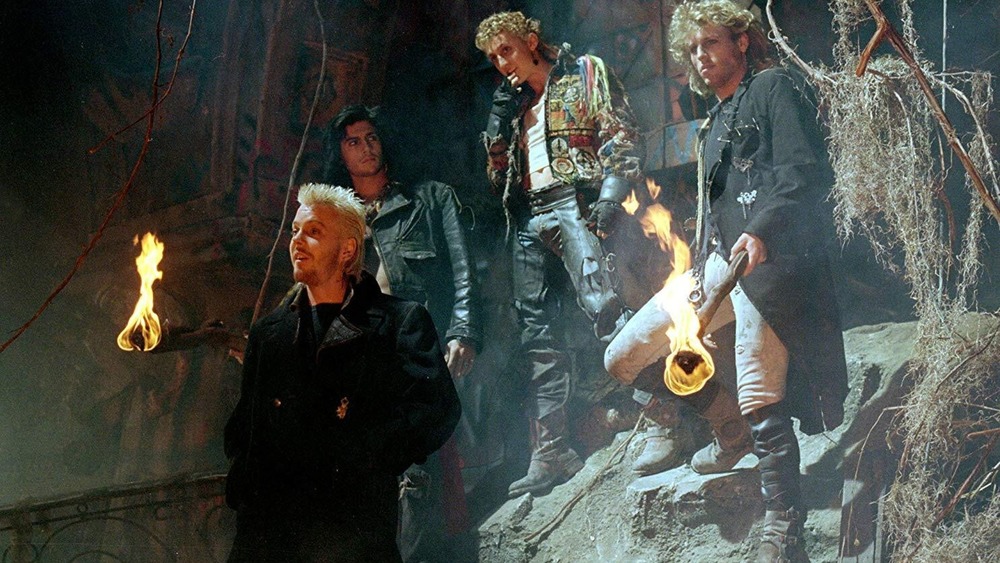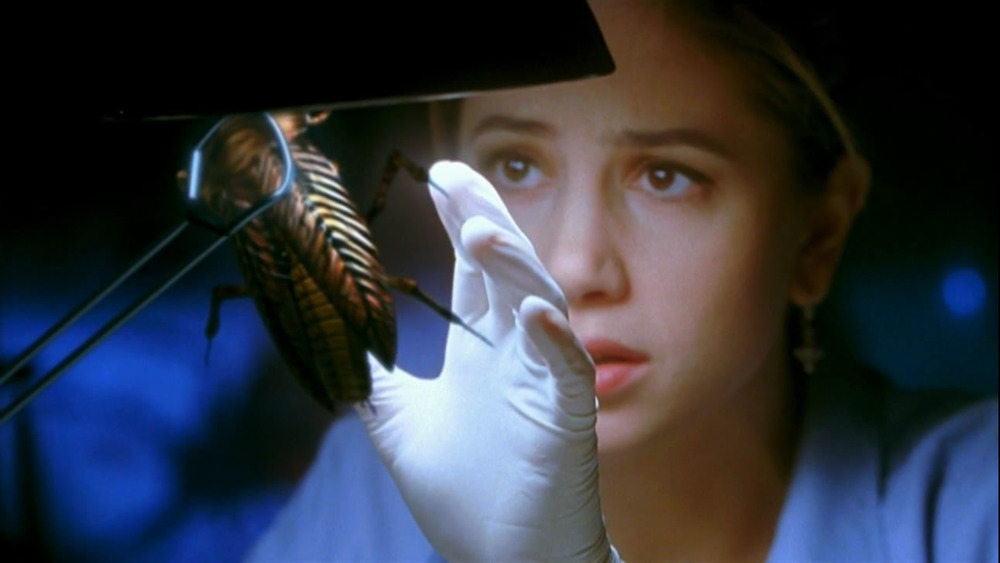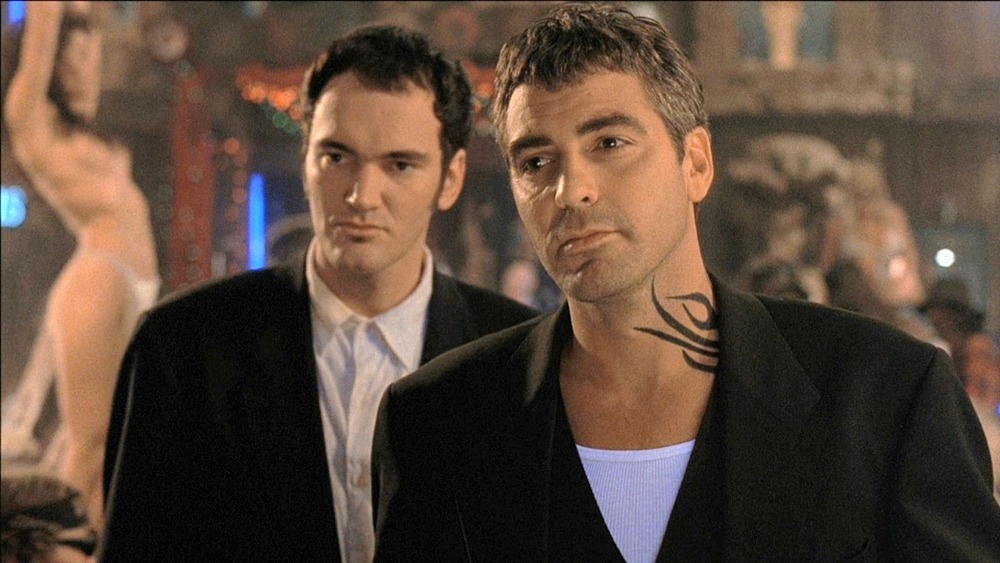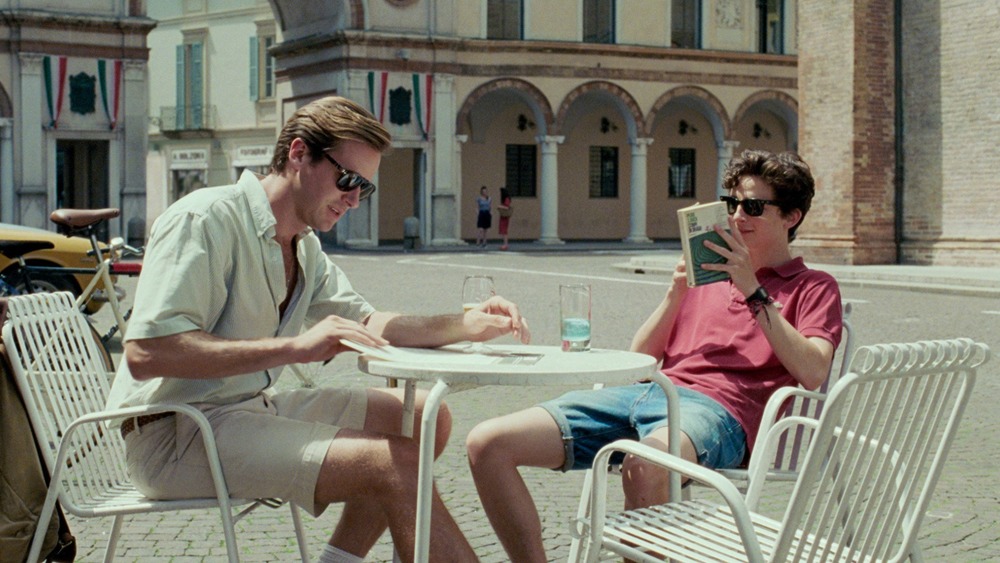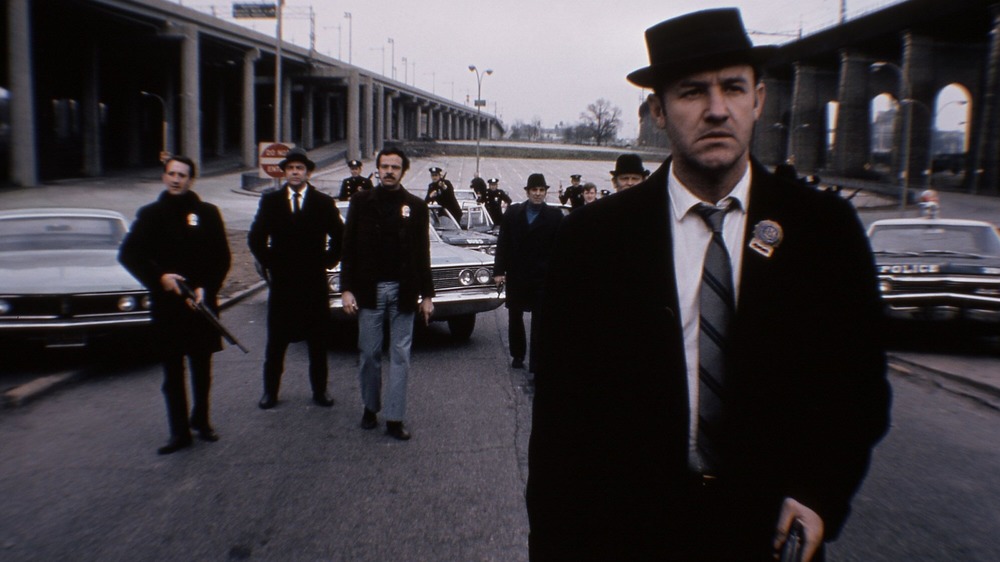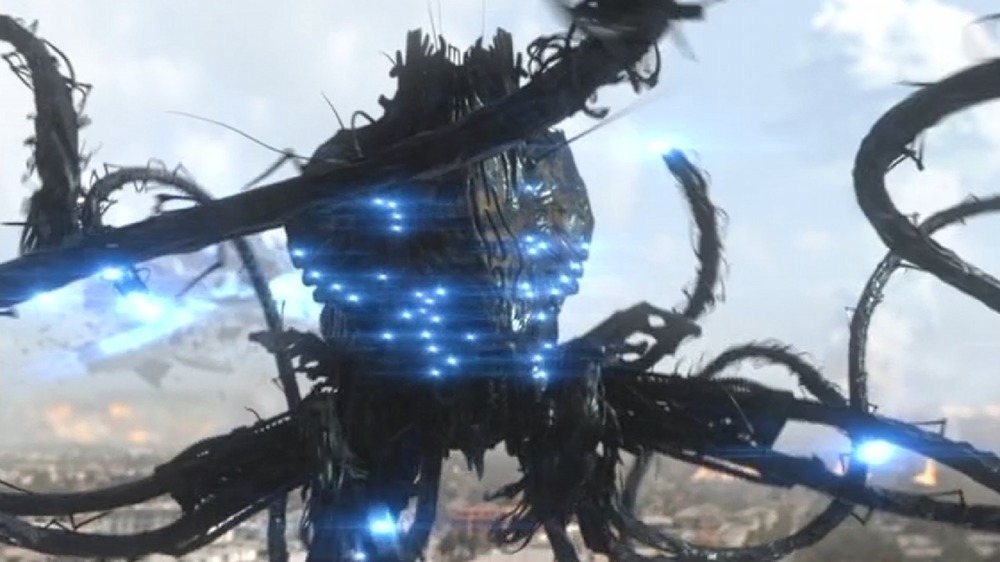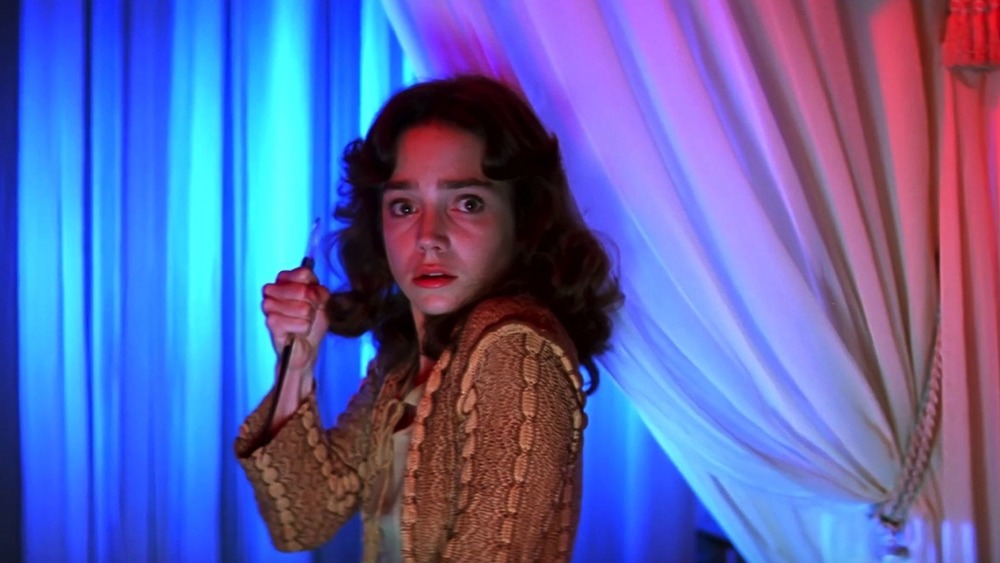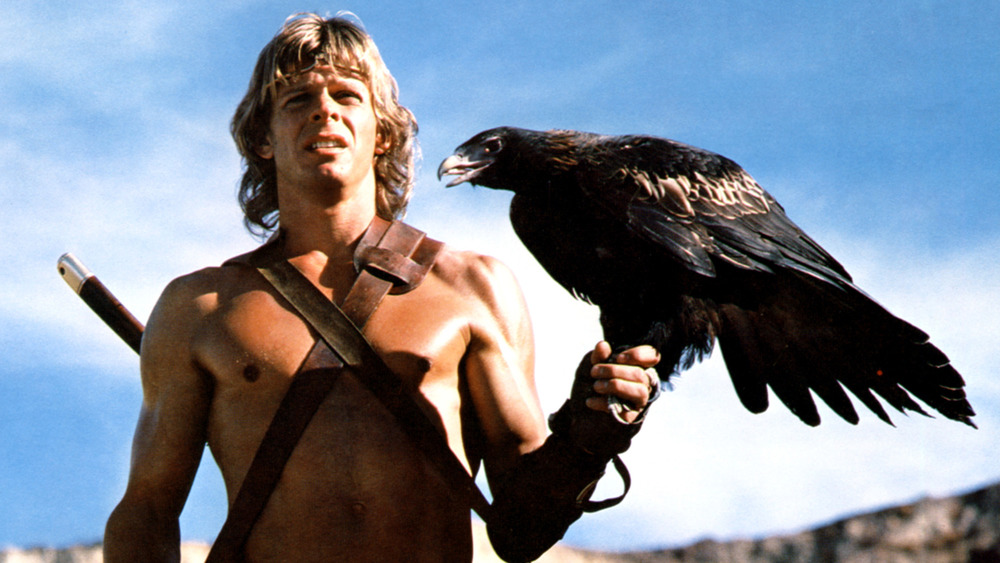Films You Didn't Know Were Part Of A Trilogy
What is a trilogy? It's a thing in three parts, right? Three books, three movies, whatever. Three parts that add up to one big story. Star Wars has three trilogies these days, although most people still only remember the first one entirely fondly. The Lord of the Rings was a trilogy of books that became a great trilogy of movies. The Hobbit, on the other hand, was one book that became a not-so-great trilogy of movies.
But what exactly makes a trilogy? Does it have to be planned as three parts from day one, like Lord of the Rings, or can it grow out of any movie that had two sequels, like Sami Raimi's Spider-Man? For the purposes of this list, we're considering any purposeful grouping of three movies as a trilogy. Some of them tell one long story, some of them tell three separate stories in sequence, and some of them are united only by the filmmaker's thematic vision. So let's dive in deep, and look at some movies you probably didn't know were part of a trilogy.
The Thing (The Apocalypse Trilogy)
John Carpenter's Apocalypse Trilogy is a season's worth of nightmares brought to terrifying life as three unique and unforgettable horror films. The Thing tells the story of an ill-fated research mission to Antarctica that finds an alien organism that can become anyone, and may have already become them without them realizing it. Prince of Darkness is a movie in which the Antichrist is a glowing green liquid in a church basement, the devil is a hand in a mirror, and Alice Cooper is the scariest homeless man you've ever seen. In the Mouth of Madness is perhaps the best cinematic adaptation of the horror of H.P. Lovecraft, even though it's not directly based on anything Lovecraft actually wrote.
Although they tell completely separate stories, the three films are connected thematically and meant to be considered together. As supernatural horror movies go, they ask more questions about the problem of evil than they answer. What does pure evil look like? Can it be killed? Will we recognize it when it's staring us in the face? What if we're simply not good enough or not strong enough to resist its many temptations? What madness awaits the souls of those who resist evil? And indeed, what if we've already given in without even realizing it?
We won't ruin the twists if you haven't seen the movies yet. If you're a Lovecraft fan — or a fan of well-done, claustrophobic horror in general — these are the films for you.
Shaun of the Dead (The Three Flavours Cornetto Trilogy)
The Three Flavours Cornetto Trilogy is named after a popular English ice cream treat. Although the three movies tell separate stories, they're all directed by Edgar Wright and star Simon Pegg and Nick Frost, as well as being written by Wright and Pegg. Shaun of the Dead turns a zombie apocalypse into an upbeat film about friendship. Deliciously weird, Hot Fuzz applies a tried-and-true gritty action movie formula to a small municipal police department in the English countryside. The World's End is a movie about a pub crawl by a group of now-middle-aged high school buddies that gets interrupted by an alien-robot invasion.
Despite their differences in genre, tone, and body count, all three Cornetto movies are about the difficulty a modern man sometimes has growing up and accepting adulthood. Shaun just wants to go to the pub every night, but his priorities begin to change when zombies attack. The cops of Hot Fuzz act like they live in an action movie, until they realize there's a real world with real consequences around them. The characters in World's End never got over high school, especially not the rootless middle aged goth played by Pegg. It takes life-threatening circumstances to shake these men out of their emotionally arrested state, but hopefully Wright's films can have a similar effect on viewers with less chance of actual bodily harm.
The Addams Family
Trilogy? We love The Addams Family. We love The Addams Family Values even more. Christopher Lloyd stole the show as a lovestruck Uncle Fester. His unlikely romance with Debbie (Joan Cusack) flung the radio of love into the hotel bathtub of our hearts. Positivity-obsessed camp counselors (Peter MacNicol and Christine Baranski) made the Addams' morbid affectations all the more appealing.
So, what's the third one? How haven't we heard about this sooner? 1998's The Addams Family Reunion is that rarest of peculiarities: a bad movie with Tim Curry in it. Good as they are as Gomez and Morticia in The Addams Family Reunion, Tim Curry and Daryl Hannah cannot compete with Raul Julia and Anjelica Huston. The other replacements fare worse.
Another ABC Family-funded abomination, The Addams Family Reunion deserves to be forgotten. Even the original cast would have struggled to make the plot about Waltzheimer's disease interesting. It's turning the Addamses normal! What a lark!
Cruel Intentions
While it might not quite live up to its source material, the 18th century novel Dangerous Liaisons by Pierre Choderlos de Laclos, Cruel Intentions remains a wildly entertaining teen film with a delightfully nasty streak. Starring Ryan Phillippe's punchable pout, Sarah Michelle Gellar's cheeky threats, Selma Blair's goofy gullibility, and Reese Witherspoon's sparkling innocence, this movie puts a wonderfully '90s spin on Pierre's misanthropic tale. Where else are you going to find step-siblings making a sex bet, a cross necklace full of cocaine, and a sapphic kiss that was literally award-winning?
Following the success of the movie, a Cruel Intentions TV series was shot, abandoned, and then allegedly re-edited with patched-in Skinemax-ready adult content and marketed as Cruel Intentions 2. Unsurprisingly, it's very bad. Cruel Intentions 3 basically just does the first Cruel Intentions again without the cast or budget, throws in some Wild Things, and leaves out what made either of those movies worth watching.
Now, if you actually watched the trailer for Cruel Intentions 2, we know what you're thinking. "Is that Golden Globe Winner Amy Adams, the talented star of Julie and Julia and Arrival?" Yes, but you should probably think more along the lines of Amy Adams from The Wedding Date and Underdog.
Dungeons and Dragons
Friends don't let friends watch the Dungeons and Dragons film trilogy. Whereas a lot of the entries on this list start with one good movie that leads to two bad sequels, Dungeons and Dragons was bad from moment one. The main problem with a Dungeon and Dragons movie, to begin with, is that the source material is a tabletop roleplaying game. That means it's all about the setting, the character archetypes, and the rules of how things work, with no ingrained story of its own. Gary Gygax's game depends entirely upon players' input — and the narrative skills of the Dungeon Masters who run the game — for its continuing appeal. You can't just slap the D&D brand on a generic knights-and-dragons fantasy film and lure fantasy nerds out of their garages and into the theaters.
In fact, Dungeons and Dragons has all the hallmarks of a garbage 1980s fantasy script that was dusted off and re-branded with minimal edits. Marlon Wayans plays the painfully stereotypical (and just generally painful) character Snails, with Jeremy Irons adding some dramatic heft to the cast (but it's far too late to save it).
And if you think Dungeons and Dragons is a mess, the two direct-to-streaming sequels, 2005's Dungeons & Dragons: Wrath of the Dragon God and 2012's
Dungeons & Dragons: The Book of Vile Darkness, certainly aren't any better. If you want to experience Dungeons & Dragons, you're going to have to get some friends together and actually play D&D. The movies will not help you; they bring only pain.
Big Momma's House
Fans who remember the originality and outrageousness of Martin Lawrence's early '90s stand-up act struggle with his present-day persona as a spiritually transformed, changed man. What do we do with Martin Lawrence's post-Bad Boys infatuation with socially conscious wholesomeness and sentimental message-peddling? On the one hand, we're glad he got his life in order. On the other, his movies were a lot better when he was still so crazy. (Runteldat? Thanks, but we'd rather not.)
Big Momma's House and Big Momma's House 2 are essentially retreads of Mrs. Doubtfire with a flimsy "FBI man goes undercover — as an old lady!" gimmick. Taking one too many pages from the Nutty Professor section of Eddie Murphy's career playbook, Lawrence has put on a fat suit and played the stereotypical mammy for cheap laughs three times. To his credit, Lawrence's Big Momma beats Tyler Perry's Madea at her own tired game, but it's still too close to minstrelsy for our comfort. We can only hope that Brandon T. Jackson's unfortunate turn in Big Mommas: Like Father, Like Son sealed this overwrought franchise's fate.
Legally Blonde
Unlike its empty-headed peers, Legally Blonde rose above a tired premise: "Dumb sorority girl becomes a shrewd lawyer to impress — and intentionally marry — the normal-nosed Wilson brother? What will your team of irreverent geniuses dream up next, MGM?" With a smart enough third act, the movie defied our jaded expectations and undid most of the destruction caused by the truly clueless TV adaptation of Clueless.
Then came the sequels. Unlike some sequels on this list, Legally Blonde 2: Red, White & Blonde retained its principal star — and that's all. Everything from the Capitol Hill setting to Witherspoon's tone-deaf getup — what was that pink pillbox hat about? — failed to impress fans and critics. Without Witherspoon, "Miss Woods Goes to Washington" would be unwatchable. (Can you tell where this is going?)
The straight-to-DVD ABC Family movie Legally Blondes rehashes the same tired blonde jokes in a prep-school setting. With neither Witherspoon's charisma nor a halfway entertaining concept to distract us from its cash-grabby one-dimensionality, this movie ought to qualify as an act of psychic war. We're surprised the filmmakers haven't been sued for damages. An "official" third installment, provisionally titled Legally Blonde 3, will seek to erase Blondes from existence when it arrives in theaters in 2022.
Desperado (The Mexico Trilogy)
Trilogies, by their expensive nature, usually require the backing of big Hollywood studios. Robert Rodriguez's Mexico Trilogy is an exception. In the trailer for El Mariachi, the first movie in the series, a big studio tries a little too hard to convince us of its devotion to independent films.
When the second film, Desperado, replaced the lead with Antonio Banderas, the series hit its high point. Once Upon a Time in Mexico, the final movie in the trilogy, was famously made in just seven weeks — a fun experiment more than a cohesive movie. Fun fact: Carlos Gallardo, who plays the title character in El Mariachi, actually appears in Desperado as El Mariachi's friend Campa. You might know him better as Deputy Carlos from Planet Terror.
Rodriguez espouses DIY filmmaking techniques and uses his ranch in Texas as a film studio, opting for digital replacements for props wherever possible. Not surprisingly, the Mexico Trilogy proves that awesome shoot-'em-up action movies can be made for a fraction of typical Hollywood budgets.
Darkman
Proving his cinematic genius yet again, Sam Raimi's Darkman takes a stupid premise and makes it pulpy and palatable. An ultra-violent antihero, Darkman's protagonist starts to die vampire-style if he gets too much sun. Darkman might have spawned the cult of Liam Neeson if Neeson's face hadn't been obscured by bandages and makeup effects for almost the entire movie.
Unfortunately, the abominable sequels mistake Darkman's stupidity for its strength. A trilogy in the technical sense only, the Darkman series follows the established tradition of an inverse relationship between quality and sequel number. The casting decisions give the game away. In Darkman II: The Return of Durant, Arnold "The Mummy to Brendan Fraser" Vosloo stepped in for Neeson. We can forgive the studio's decision to sub in mute Mr. Clean the scarab romancer for the swashbuckling, wolf-fighting, England-resisting, Batman-antagonizing, thricely Taken with revenge Liam Neeson. At least the bad guy is Robert G. Durant, played once again by Larry Drake.
In Darkman III: Die Darkman Die, Jeff Fahey provides the villainy. Akin to the Tim Burton-produced, Joel Schumacher-directed Batman sequels, the Darkman series' later entries neutered the movies by putting the original movie's director in the role of executive producer and hiring a competent, though bland, director to take his place. Originally, Part III was going to be Part II and vice versa. That's the extent of the sequels' superfluity in the franchise; the chronology makes no difference. Unless you have a thing for low-budget sequels, you can skip from Darkman to the 2012 fan-made film.
XXX
The XXX series is all about explosions, fights, and tacky one-liners. The first movie cashed in on Vin Diesel's Fast and Furious street cred. In it, Diesel does what he can with the title role as one-note badass Xander "XXX" Cage, but the prefab script gives him little to work with.
XXX: State of the Union's switch from Diesel to Ice Cube might have seemed ill-advised, but Cube's charisma and sense of wonder as criminal mastermind-turned-secret agent Darius Stone carried this absurd example of popcorn cinema. The talents of Sam Jackson and Willem Dafoe go underutilized — but so what? Nobody is going to see XXX: State of the Union for dramatic nuance. Diesel returned for the belated third installment, 2017's XXX: Return of Xander Cage, and the results were basically what you'd expect — in other words, those who weren't already fans of this set piece-stuffed series seriously need not investigate.
Oldboy (The Vengeance Trilogy)
Directed by Park Chan-wook, Oldboy won the Grand Prix at Cannes, introduced a whole lot of people to Korean cinema, and left audiences absolutely speechless with its pervy third act. It's also the gold standard for hallway fights, and it featured an octopus-eating scene that will never — and should never — be topped. Sadly, the movie inspired an inferior sequel that just couldn't compare to the epic Greek tragedy of the original film, but if you want to further explore the twisted mind of Park Chan-wook, then you're in luck, because Oldboy is actually the second installment in the director's bloodsoaked "vengeance trilogy."
This thematic series got started in 2002 with Sympathy for Mr. Vengeance, the story of a man seeking revenge for the death of his daughter. However, the case isn't that cut and dry since her accidental murderer was part of a kidnapping scheme that was meant to save his sister's life. In 2003, we got Oldboy, the story of a man mysteriously imprisoned for 15 years, and when he's released one day, he decides it's hammer time. Park finished his trilogy with Lady Vengeance, the story of a woman who takes the fall for a crime she didn't commit, and when she's released from prison, she decides to hunt down the man responsible.
The trilogy of movies revolve around the concept of vengeance, especially the idea that getting even never actually solves one's problems. Revenge is messy, bloody, and morally murky. People are tortured, bad guys are murdered, but by the end of these movies, the "heroes" are never better off. In fact, they've often become the very monsters they sought to destroy. While each film explores these ideas in slightly different ways, the vengeance trilogy is a must-watch series for fans of Korean movies, gore-soaked cinema, and stories that aspire to the bloody heights of Shakespeare.
The Creature from the Black Lagoon (The Gill-Man Trilogy)
One of the all-time great monster movies, The Creature from the Black Lagoon, introduced the world to the Gill-man, the scaliest member of the Universal Monsters. And like his equally iconic cohorts, old Gilly inspired a franchise that would cause us to both fear and feel sorry for this prehistoric creature.
The whole concept of the Gill-man got started when producer William Alland attended a dinner party at Orson Welles' house. There, he met a cinematographer who told the story of a reptilian monster that lived in the Amazon and occasionally kidnapped native women. This bizarre anecdote inspired Alland, who created the famous first film — a tale of several explorers who travel to South America and encounter an amphibious beast with a thing for women in one-piece bathing suits.
The movie was released in 3-D, and it was an immediate hit, but according to Den of Geek, before production was even finished, Universal was already setting up the next entry in a new series. (Hollywood has been in the sequel business for a long time.) The follow-up was titled Revenge of the Creature, and, in this film, after the Gill-Man is captured, put on display, and tortured by scientists, our fishy friend decides it's time to strike back.
After Gill-man exacts revenge, things then get super weird in the final film, The Creature Walks Among Us. In this odd entry, the Gill-man is set on fire, and most of his scales are burned off. Then, after undergoing surgery, the creature comes out looking incredibly human-like. The rest of the film follows the Gill-man as he tries to adjust to the human world, all while dreaming of his home beneath the water. Yeah, it's pretty different from the original, but all three movies take a sympathetic view of a scary-looking monster, a creature that starts off wanting love but finally just wants to be left alone.
Creep (The Creep trilogy)
Directed by Patrick Brice, Creep finds Mark Duplass going from mumblecore to murder, playing an uncomfortably eerie dude who hires a videographer (Brice) to help him make a movie for his unborn son. As the day stretches on, Brice starts suspecting this weirdo might have something more on his mind than filming a farewell video. With Duplass wearing a wolf mask, Creep is a disturbingly effective found footage film that breathed new life into a tired old genre, but while it scored high marks on Rotten Tomatoes, it didn't exactly feel like a movie that would produce a sequel.
Fortunately, the gods of horror cinema smiled upon us and gave us Creep 2, which just so happens to be one of the greatest horror sequels of all time. While it's done in the same found-footage style as the original, the sequel goes in a completely different direction. This time around (spoilers), we know from the very beginning that Duplass is a serial killer, but he's also losing his lust for life — and for taking lives. That all changes when he meets a YouTuber (Desiree Akhavan) hoping to make an incredibly creepy vlog, and as the killer grows closer to his new collaborator, he begins to rediscover his old passion.
In addition to being a horror film, Creep 2 is a blackhearted meta-comedy that examines both the found footage genre and the very idea of filmmaking. And as Kevin Lincoln of Vulture writes, the movie also poses some interesting questions about "why we're interested in serial killers in the first place." But after the hilariously scary Creep 2, where will the franchise go next? Well, at the Telluride Horror Show, director Patrick Brice confirmed there will be a third film, and on the Phantom Podcast Network, he explained part three will be a whole lot weirder than the first two movies. Comparing Creep 2 to Evil Dead 2, Brice promised the third movie will be "our Army of Darkness... going kind of off the rails."
Sicario (The Frontier Trilogy)
Coming off Sons of Anarchy, Taylor Sheridan decided it was time to write Sicario, a brutal screenplay about America's war on drugs and the nightmarish violence along the U.S.-Mexican border. Eventually, the script picked up some incredible actors like Emily Blunt, Benicio del Toro, and Josh Brolin, not to mention director Denis Villeneuve and cinematographer Roger Deakins. When it hit theaters in 2015, this bloody thriller killed it with critics.
Sheridan's next project was the equally impressive Hell or High Water, a modern-day Western that follows two West Texas brothers (Chris Pine and Ben Foster) as they rob banks in one economically desolate town after another. The script earned Sheridan an Oscar nomination (and one for Jeff Bridges for his turn as a surly Texas Ranger). A year later, Sheridan made his directorial debut with Wind River, a movie set in the snowy wilderness of Wyoming, where a hunter (Jeremy Renner) and an FBI agent (Elizabeth Olsen) try to solve the murder of a Native American woman.
While there aren't any characters linking the films together, Sheridan has described his films as a "frontier trilogy." Talking with the Associated Press, Sheridan explained his movies are "an exploration of the modern American frontier and how much has changed and how much hasn't changed and the consequences of assimilation that still reverberate today." The movies are an examination of the secret struggles and brutal realities of living in the rural U.S.; it's a trilogy about the forgotten people of North America and how they're desperately trying to survive.
Jarhead (The Jarhead Trilogy)
Certain movies — especially prestigious war movies — don't seem like they should be part of a trilogy. Nobody would make Platoon Part Three or a sequel to Saving Private Ryan. And you probably wouldn't expect a franchise to pop up around Jarhead, the 2005 film set during Desert Storm. Directed by Sam Mendes, the original film boasts a pretty incredible cast, featuring some serious actors like Jake Gyllenhaal, Jamie Foxx, and Chris Cooper. Jarhead is based on a true story and follows a group of frustrated, bored soldiers burning away in the desert sun. As Roger Ebert put it, Jarhead "contains no heroism, little action, no easy laughs," but despite its anti-war message, this movie somehow inspired a super gung-ho action franchise full of bad writing, badass soldiers, and bloody gun battles.
In other words, parts two and three are the complete opposite of the original.
Jarhead 2: Field of Fire was a direct-to-video sequel released by Universal Home Entertainment in 2014, and it features more shootouts than the first film has characters. Starring some recognizable names like Cole Hauser, Bokeem Woodbine, and Stephen Lang, the sequel follows a completely different group of Marines protecting an Afghani woman who's basically Malala Yousafzai. The Taliban wants her dead, and our heroes fire a whole lot of bullets getting the girl to safety.
As for Jarhead 3: The Siege, all we can say is "The horror! The horror!" Yeah, it's pretty awful. Once again featuring totally different characters, this direct-to-video B-movie borrows its premise from the 2012 Benghazi attack, and it's pretty much a straight-up pro-war flick, complete with racist one-liners. In other words, the Jarhead series has strayed far afield from the original entry, but evidently, somebody's watching these movies, so part four might invade your TV screen sometime soon.
Open Water (The Open Water Trilogy)
It's a scientific fact that sharks are the scariest animals on the planet, so it should come as no surprise that Open Water terrified everyone at Sundance and then scared up $54 million against a $500,000 production budget. This aquatic indie was directed by husband and wife filmmakers Chris Kentis and Laura Lau, and the story followed another (far unluckier) couple who are stranded in the Great Barrier Reef and desperately trying to avoid becoming, ahem, sushi for the sharks.
With such an impressive showing at the box office, it was only a matter of time before a sequel came swimming along, but what's weird about Open Water 2: Adrift is that there's not a single shark in sight. That's right. No sharks. As explained by Brian Collins on his blog Horror Movie a Day, this sequel was originally just titled Adrift. It had nothing to do with the movie by Kentis and Lau, but then some executive came along and stuck the name Open Water on the poster, even though, as we keep pointing out, there aren't any sharks. As for the plot, it follows a bunch of idiots who jump off their yacht to go swimming, only they forget to lower the ladder first. Stranded in the ocean, our forgetful heroes desperately try to get back on board, all while never having to worry about flesh-eating fish.
Then came Open Water 3: Cage Dive, released straight to video by Lionsgate. It focuses on a group of Americans who go, you guessed it, cage diving off the coast of Australia. This time, sharks actually show up, and soon our scuba divers are nothing more than a smorgasbord. Needless to say, Open Water 3 isn't what you'd call a masterpiece, and, as of this writing, it doesn't even have its own Wikipedia entry. But hey, as bad as it is, at least Open Water 3 has, you know, sharks.
Mute (The Moon-iverse Trilogy)
Duncan Jones, the man behind Source Code and Warcraft, spent 15 years working on his passion project, a sci-fi noir called Mute. Despite a myriad of personal and professional problems that slowed him down, Jones soldiered on and finally finished his own futuristic version of Casablanca. A Netflix film, Mute follows a silent bartender (Alexander Skarsgard) who's searching for his missing girlfriend (Seyneb Saleh), but as he digs deeper into the mystery, he keeps running across two shady surgeons (Paul Rudd and Justin Theroux) on his quest to find his lady fair.
Based on the trailer, you'd never guess this was the second installment of a trilogy, but according to Jones, Mute takes place in the same universe as Moon, his critically acclaimed space drama that stars Sam Rockwell as a lonely astronaut who discovers a shocking secret on his isolated moon base. Jones calls his cinematic world "the Moon-iverse," and he promised that a third film would eventually come along to complete his science fiction trilogy. After teasing that the next chapter would "have a female lead" and would focus on two sisters, Jones eventually crowdfunded the project as a graphic novel titled Madi: Once Upon a Time in the Future, which was published in late 2020.
The Lost Boys (The Lost Boys trilogy)
A 1980s classic, The Lost Boys is basically The Goonies meets Dracula, which might be the craziest elevator pitch of all time. Directed by Joel Schumacher, the film follows two brothers (Jason Patric and Corey Haim) who move to the bloody city of Santa Carla, the murder capital of the world. Naturally, the two have a difficult time settling into their new home, especially since they're welcomed to the neighborhood by a gang of motorcycle-riding vampires that includes a fanged Jack Bauer (Okay, it's Kiefer Sutherland, but still) and an undead Bill on a different kind of excellent adventure (and sans Ted).
Despite the movie's success at the box office, The Lost Boys laid dormant for over 20 years. For a brief moment, there was talk of a sequel titled The Lost Girls, but unfortunately that awesome idea never came to pass. Instead, in 2008, we got the Lost Boys: The Tribe, a movie that basically stole the first film's plot. New kids move into town. They meet vampires, the leader of whom is played by a member of the Sutherland clan. When things start getting freaky, our heroes turn to a vampire hunter played by Corey Feldman. And with such an original plot, it should come as no surprise that The Tribe has a zero percent rating on Rotten Tomatoes.
While the Lost Boys: The Thirst has the same awful rating, at least it tries a little harder in the plot department. Released in 2010, the movie follows Feldman as aged vampire slayer Edgar Frog who's forced to team up with a Stephenie Meyer stand-in (Tanit Phoenix) to stop a group of vampires who plan on using a demonic drug (vampire blood) to transform partygoers into undead monsters. Of course, the third entry can't hold a crucifix to the original film, so maybe it's time for Warner Bros. to stake this series in the heart.
Mimic (The Mimic Trilogy)
Thanks to Guillermo del Toro's love for creepy creatures, we've been gifted with some truly incredible films like Pan's Labyrinth and The Shape of Water. But before del Toro was known for being a maestro of monsters, he struggled with a little creature feature called Mimic. The man had a creative vision, but the studio wanted something different, and the resulting film is not one of del Toro's best. Nevertheless, the movie has its moments, and it's got a pretty cool premise involving giant cockroaches that fool their human victims by impersonating people.
While the movie was not a box office success, evidently it had that certain something, because somebody at Dimension Films thought it had franchise potential. Mimic 2 was released direct to DVD in 2001, and it played like an ickier version of Beauty and the Beast. The sequel followed an entomologist from the first film (Alix Koromzay) who's being stalked by a jealous, humanoid insect that wants her for, well, uh, romantic purposes.
Interestingly, the third film — Mimic 3: Sentinel, released straight to video in 2003 — borrows the plot from Rear Window by having its voyeuristic hero trapped inside an apartment, watching the world through his camera. However, his spying soon turns into sleuthing when he slowly realizes there's something strange happening across the street... something that might involve some very hungry bugs. This trilogy capper did surprisingly well with the few critics who saw it. After all, who doesn't want to watch an Alfred Hitchcock movie involving killer cockroaches?
From Dusk till Dawn
Written by Quentin Tarantino and directed by Robert Rodriguez, From Dusk till Dawn is a cult classic. Released in 1996, it stars Tarantino and George Clooney as criminal brothers who escape to Mexico after killing several people in the course of their robberies. They plan to spend the night hiding out at a strip club before meeting their contact at dawn. What they don't know is that the bar is staffed entirely by vampires, and soon all hell breaks loose in an orgy of blood and violence. As well regarded as From Dusk till Dawn still is, however, nobody remembers its two sequels.
For one thing, From Dusk till Dawn has an amazing cast of '90s stars. In addition to Tarantino and Clooney, it features Harvey Keitel, Juliette Lewis, Salma Hayek, Danny Trejo, and Cheech Marin. Of all its stars, only Danny Trejo (an actor who seems to say yes to everything) returned for 1999's From Dusk till Dawn 2: Texas Blood Money. Instead of Clooney and Tarantino, it stars Robert Patrick and Duane Whitaker. It's also not written and directed by Tarantino and Rodriguez, and it was released directly to video. A forgettable effort all around.
From Dusk till Dawn 3: The Hangman's Daughter, which got a direct to video release in 2000, is actually a prequel set in the early 1900s. It features even less star power than the second one (anybody remember Rebecca Gayheart?), but at least Danny Trejo is still there.
Call Me by Your Name (The Desire Trilogy)
In 2017, Call Me By Your Name was a huge success as independent movies go, gaining much critical acclaim and four Oscar nominations (it won Best Adapted Screenplay). The gay love story starred Armie Hammer and Timothée Chalamet in a whirlwind summertime romance with an age difference that made some viewers uncomfortable — Hammer's character was 24 but looked older, while Chalamet's character was 17 but seemed younger. Despite all the discussions that went on in public and in private about Call Me By Your Name, however, few American viewers realized it was actually the third installment in a trilogy.
Italian director Luca Guadagnino is deeply interested in the desire that human beings feel for one another, and he spent the better part of a decade making a trilogy of narratively unrelated films on that theme. The first was I Am Love in 2009, which starred Tilda Swinton as the wife of a wealthy industrialist who has a passionate affair with a chef. Then in 2015 came A Bigger Splash, which also starred Swinton, this time as a rock star torn between past and present lovers, even as her current boyfriend is tempted by a younger woman.
Call Me By Your Name is the only film in Guardagnino's Desire Trilogy not to feature Swinton, but it shares thematic elements and picturesque Italian settings with those first two installments.
The French Connection
The French Connection, directed by William Friedkin, is an inarguable classic. The gritty story of New York detective Popeye Doyle (Gene Hackman) and his attempt to thwart a heroin-smuggling operation influenced crime cinema for decades to come. Released in 1971, it's still considered a must-see for cinephiles today. But despite how many people still watch The French Connection, hardly anybody watches French Connection II, and most people don't even know there was a third movie in the series.
Hackman returned as Popeye Doyle for French Connection II, with John Frankenheimer taking over directorial duties. It features Popeye traveling to France in pursuit of Alan Charnier (Fernando Rey), the drug smuggler who escaped at the end of the first film. Rey is the only other cast member besides Hackman to return for the sequel. The film features harrowing scenes of addiction and recovery as Doyle is captured by Charnier and injected with heroin as an interrogation tactic. By the time Charnier lets him go, Popeye Doyle is a junkie, and must go cold turkey in a French police station holding cell.
The third film to pick up the story is called Popeye Doyle, and it stars Ed O'Neill as the title character. It was made for television, and seemed designed as the launching point for a television series, but no series happened. Still, even if it was more of a TV pilot, it was clearly established as a further story about the same character from the first two films (even though he's gone from Gene Hackman to Al Bundy), so it counts as the completion of a trilogy.
Skyline
The 2010 sci-fi action film Skyline is less like a piece of cinema and more like a wild, over-the-top thrill ride. It stars Eric Balfour and Scottie Thompson as Jarrod and Elaine, a married couple with a baby on the way, who are attending a friend's birthday party when aliens suddenly invade Los Angeles. The mysterious aliens use their technology to mesmerize the populace and then scoop the people up into their ships. The film has a truly strange ending, which we will now spoil for those who are curious but not curious enough to watch it: Jarrod and Elaine are captured and taken aboard an alien ship, where Jarrod's brain is quickly extracted from his body and put into a biomechanical alien body. For some reason Jarrod's brain glows red instead of blue like the other alien drones, which means he retains his memories and personality. The movie ends with alien Jarrod protecting his still-human wife and unborn child from the other aliens.
Things get even weirder in Beyond Skyline, a sequel in which Elaine's pregnancy is accelerated and so is the growth of the daughter she births. Along the way, a resistance against the aliens begins to come together, including other alien drones who manage to maintain their inner humanity as Jarrod did. The third movie in the trilogy, Skylines, gets weirder still as humanity and their half-human allies finally manage to defeat the aliens ten years later, under the leadership of Rose, Jarrod and Elaine's grown adult 10-year-old daughter. Liam O'Donnell directed all three movies, so there does seem to be an artistic vision at work, no matter how little sense it seems to make.
Suspiria (The Three Mothers Trilogy)
Suspiria (the original 1977 film, not the 2018 remake) is the most famous film by legendary Italian horror filmmaker Dario Argento. It stars Jessica Harper as Suzy Bannon, a young American woman who arrives at a prestigious German dance academy. All around her, other young women are dying for weird reasons, and Suzy begins to suspect that the school is run by a coven of witches. She turns out to be correct, and all the witches are in the service of one unspeakably ancient witch who goes by the name Helena Markos. On one level, Suspiria is a stand-alone horror film which ends with Suzy defeating Markos by stabbing her in the neck. However, Markos was never the only ancient witch in Argentos' world, and he made movies to tell the stories of the other two.
Inferno is the second movie in Argento's Three Mothers trilogy, released in 1980. It stars Irene Miracle as Rose Elliott, a poet living in New York City. At the beginning of the film, Rose finds a book about the Three Mothers, evil sisters who rule the world with sorrow, tears, and darkness, and dwell inside separate homes built just for them. Mater Suspiriorum, the Mother of Sighs, lives in Freiburg, Germany (where the dance school in Suspiria was). Mater Lachrymarum, the Mother of Tears, lives in Rome, and Mater Tenebrarum, the Mother of Darkness, lives in New York. Rose begins to expect that the Mother of Darkness lives in her apartment building, and of course she turns out to be right.
It took almost 30 years, but Argento finally released the final Three Mothers film, Mother of Tears, in 2007. Set in Rome, naturally, and starring Asia Argento, Dario's daughter, it finally put to bed the threat of all three evil mothers in the modern world.
The Beastmaster
The Beastmaster, directed by Don Coscarelli, is one of the better sword and sorcery movies of the early 1980s. It stars Marc Singer as a barely dressed hero named Dar who talks to animals — specifically a golden eagle, two ferrets, and a panther, who all accompany him on his adventures. He does battle with an evil wizard, as all sword and sorcery heroes must, and even discovers he was born a prince, although he has no interest in being king.
The Beastmaster told a complete story that seemed to require no sequels, and for nine years it had none. During that time, it gained many fans thanks to playing constantly on cable television, and in 1991 a sequel finally came. Beastmaster 2: Through the Portal of Time features Dar and his animal friends following two new villains through the titular portal to early '90s Los Angeles, where they have plenty of fish-out-of-water jokes to go along with the sword-swinging action.
A third movie, Beastmaster III: The Eye of Braxus, aired on television in 1996. It featured genre favorite Tony Todd as an ally of Dar's, who helps him rescue his younger brother from the forces of evil. Sadly, the third movie is neither as good as the first nor as all-out ridiculous as the second. It's just a bit generic, and Marc Singer is starting to look a bit old for the role. If you've never seen a Beastmaster, definitely watch the first. Watch the second if you have time to kill, but you can safely steer clear of the third.
